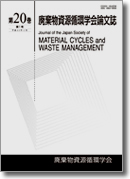Volume 20, Issue 6
Displaying 1-6 of 6 articles from this issue
- |<
- <
- 1
- >
- >|
Paper
-
2009Volume 20Issue 6 Pages 343-351
Published: 2009
Released on J-STAGE: January 13, 2010
Download PDF (727K) -
2009Volume 20Issue 6 Pages 352-360
Published: 2009
Released on J-STAGE: January 13, 2010
Download PDF (547K) -
2009Volume 20Issue 6 Pages 361-370
Published: 2009
Released on J-STAGE: January 13, 2010
Download PDF (403K) -
2009Volume 20Issue 6 Pages 371-382
Published: 2009
Released on J-STAGE: January 13, 2010
Download PDF (566K) -
2009Volume 20Issue 6 Pages 383-393
Published: 2009
Released on J-STAGE: January 13, 2010
Download PDF (650K) -
2009Volume 20Issue 6 Pages 394-400
Published: 2009
Released on J-STAGE: January 13, 2010
Download PDF (473K)
- |<
- <
- 1
- >
- >|
